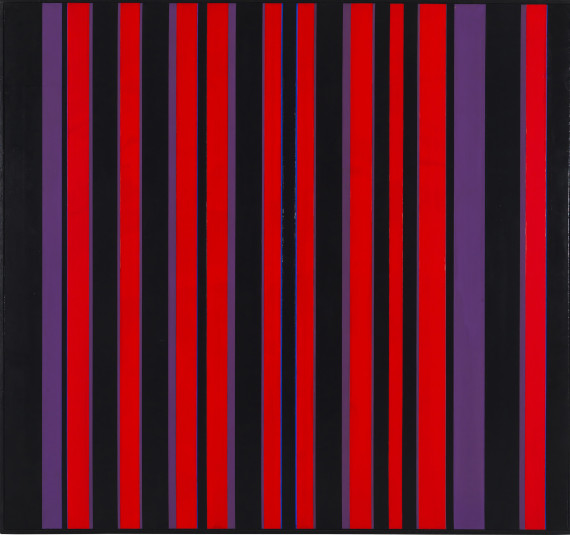35
Günter Fruhtrunk
Hommage à Duccio, 1968.
Acrylic on canvas
Estimate:
€ 120,000 / $ 128,400 Sold:
€ 177,800 / $ 190,246 (incl. surcharge)
Hommage à Duccio. 1968.
Acrylic on canvas.
Reiter 548. Signed, monogrammed, dated, titled and inscribed on the reverse. 168.5 x 180 cm (66.3 x 70.8 in).
• Early work from the most important creative period - shown at the Kestner-Gesellschaft during the artist's lifetime.
• Pursuing reorientation with persistence, Günter Fruhtrunk added very own dynamics to Constructivism.
• In 1968, the year this work was made, Fruhtrunk participated in both the Venice Biennale and the documenta in Kassel.
• Currently, the Kunstmuseum Bonn honors the artist with a grand retrospective on the occasion of his 100th birthday.
PROVENANCE: Galerie Der Spiegel, Cologne (with the label on the stretcher).
Private collection North Rhine-Westphalia.
EXHIBITION: Deutsche Avangarde 1. Günter Fruhtrunk, Raimund Girke, Georg Karl Pfahler, Kestner Gesellschaft, Hanover, 1969, cat. no. 22.
Prinzip Vertikal, Europa nach 1945, Galerie Teufel, Cologne, November 9, 1979 - February 2, 1980, ex. cat., p.49 with color illu.
LITERATURE: Lempertz, Cologne, December 3, 2016, lot 414.
Acrylic on canvas.
Reiter 548. Signed, monogrammed, dated, titled and inscribed on the reverse. 168.5 x 180 cm (66.3 x 70.8 in).
• Early work from the most important creative period - shown at the Kestner-Gesellschaft during the artist's lifetime.
• Pursuing reorientation with persistence, Günter Fruhtrunk added very own dynamics to Constructivism.
• In 1968, the year this work was made, Fruhtrunk participated in both the Venice Biennale and the documenta in Kassel.
• Currently, the Kunstmuseum Bonn honors the artist with a grand retrospective on the occasion of his 100th birthday.
PROVENANCE: Galerie Der Spiegel, Cologne (with the label on the stretcher).
Private collection North Rhine-Westphalia.
EXHIBITION: Deutsche Avangarde 1. Günter Fruhtrunk, Raimund Girke, Georg Karl Pfahler, Kestner Gesellschaft, Hanover, 1969, cat. no. 22.
Prinzip Vertikal, Europa nach 1945, Galerie Teufel, Cologne, November 9, 1979 - February 2, 1980, ex. cat., p.49 with color illu.
LITERATURE: Lempertz, Cologne, December 3, 2016, lot 414.
Günter Fruhtrunk was born in Munich in 1923. From 1940 he studied architecture at the Technical University of Munich for a short time. However, neither Munich nor other art centers in Germany could stimulate Fruhtrunk's artistic interest. Instead Paris, where he felt more at home than in Germany, would become his place of inspiration. In 1951 he went to Paris to study. The first important artistic impulses came from Willi Baumeister and Julius Bissier, which allowed Fruhtrunk to turn to abstraction. In Paris it was Léger and Arp who inspired him, and in 1954 Fruhtrunk made Paris his permanent home. Although the city was the intellectual and artistic center of the then prevailing Tachisme, Fruhtrunk vehemently worked on his own paradigm of abstraction far from the gestural. With the means of construction and mathematical precision, he conceived a visual language characterized by a strong reduction. His compositions are determined by vertical and horizontal stripe formations. Fruhtrunk used ideas of Constructivism that he developed into his own colorful, rhythmic imagery. In 1967, Fruhtrunk accepted a post at the academy in Munich, but he was allowed to stay in Paris, as he only had to be in Munich for three weeks every semester. In 1968, he took part in both the 34th Venice Biennale and the 4th documenta in Kassel, the two most important exhibitions of contemporary art. While Fruhtrunk's early works are characterized by isolated geometric shapes that form into intertwined and dense strips of color, in the year "Hommage à Duccio" was created, the striped shapes develop into format-filling vertical stripes that take up the entire length of the picture. Lines and fields of different widths, as well as repeated colors, indicate a rhythm that gradually unfolds before the eye of the beholder. In addition, the individual components allow for a constant change of perception between foreground and background. Strict in a classic sense, but at the same time extremely exciting due to the alternating rhythm, while the color values remain constant. The color was his creative medium, which he wanted to liberate from any 'heteronomy', from a traditional cultural perception and from an individual interpretation. By activating the process of seeing, his pictorial language aims at a state that Fruhtrunk himself describes as ‘being free to see’. Six variations of "Hommage à Duccio" were made, of which the present work is the largest version. Alternating stripes in black, violet and red line up. The black elements are occasionally accentuated by narrow blue lines. The vertical alignment of the stripes intensifies the focus on the colors and their composition, their contrast creating a dynamic effect. Fruhtrunk shows color as optical energy and, with his artistic approach, he was a representatives of Concrete Art. On the occasion of his 100th birthday, Fruhtrunk was honored with a grand retrospective at the Kunstmuseum Bonn and thus receives the long overdue appreciation of his internationally important contribution to post-war abstraction. [SM]
35
Günter Fruhtrunk
Hommage à Duccio, 1968.
Acrylic on canvas
Estimate:
€ 120,000 / $ 128,400 Sold:
€ 177,800 / $ 190,246 (incl. surcharge)


 Lot 35
Lot 35 

